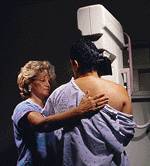 |
 |
 |
||
    |
||||
|
||||

Young Women's Breast Tissue Offers Clues to Cancer Risk
Tissue density tied to chances of disease in middle-age and beyond, study suggests|
|
HealthDay
By Robert Preidt
Thursday, April 30, 2009
 WEDNESDAY, April 29 (HealthDay News) -- Breast cancer risk assessment and prevention should start much earlier in life than it currently does, say Canadian researchers who examined breast cancer risk factors in young women.
WEDNESDAY, April 29 (HealthDay News) -- Breast cancer risk assessment and prevention should start much earlier in life than it currently does, say Canadian researchers who examined breast cancer risk factors in young women.
The study of 400 women, ages 15 to 39, and their mothers found that breast tissue composition in young women may be associated with their risk for breast cancer in middle age and older.
"It is known that the breast is most susceptible to the effects of carcinogens at early ages. Our findings suggest that differences in breast tissue composition in early life may be a potential mechanism for this increased susceptibility," wrote a team led by D. Norman Boyd, of the Campbell Family Institute for Breast Cancer Research, Toronto. By identifying the environmental and genetic factors that influence breast tissue composition early in life, we may be able to develop safe and effective methods of prevention."
In this study, the researchers looked at the amount of dense breast tissue (mammographic density, or MD), which varies considerably among women and is a significant risk factor for breast cancer in middle-aged and older women.
Experts know that the risk of breast cancer increases as MD increases. However, little has been known about the development of MD early in life or how the MD of young women is related to their height, weight, age, and their mother's MD.
The study authors concluded that a "high degree of mammographic density in middle age, when it is a strong risk factor for breast cancer, may arise from the subset of the population with the greatest amount of fibro-glandular tissue in early life, when susceptibility to potential carcinogens is greatest. Interventions directed at the prevention of breast cancer may therefore be more effective if they are started in early life rather than adult life."
The study appears online and in the June print issue of the The Lancet Oncology.
HealthDay
Copyright (c) 2009 ScoutNews, LLC. All rights reserved.
Related News:
More News on this Date
Related MedlinePlus Pages:
| Home | Health Topics | Drugs & Supplements | Encyclopedia | Dictionary | News | Directories | Other Resources | |
| Disclaimers | Copyright | Privacy | Accessibility | Quality Guidelines U.S. National Library of Medicine, 8600 Rockville Pike, Bethesda, MD 20894 National Institutes of Health | Department of Health & Human Services |
Date last updated: 01 May 2009 |
